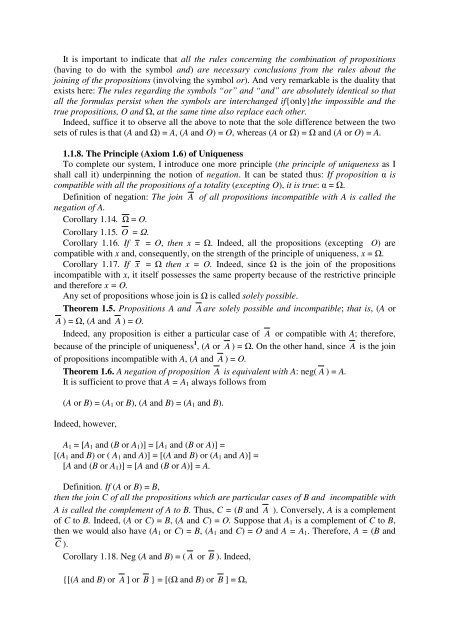kniga 7 - Probability and Statistics 1 - Sheynin, Oscar
kniga 7 - Probability and Statistics 1 - Sheynin, Oscar
kniga 7 - Probability and Statistics 1 - Sheynin, Oscar
Create successful ePaper yourself
Turn your PDF publications into a flip-book with our unique Google optimized e-Paper software.
It is important to indicate that all the rules concerning the combination of propositions(having to do with the symbol <strong>and</strong>) are necessary conclusions from the rules about thejoining of the propositions (involving the symbol or). And very remarkable is the duality thatexists here: The rules regarding the symbols “or” <strong>and</strong> “<strong>and</strong>” are absolutely identical so thatall the formulas persist when the symbols are interchanged if{only}the impossible <strong>and</strong> thetrue propositions, O <strong>and</strong> , at the same time also replace each other.Indeed, suffice it to observe all the above to note that the sole difference between the twosets of rules is that (A <strong>and</strong> ) = A, (A <strong>and</strong> O) = O, whereas (A or ) = <strong>and</strong> (A or O) = A.1.1.8. The Principle (Axiom 1.6) of UniquenessTo complete our system, I introduce one more principle (the principle of uniqueness as Ishall call it) underpinning the notion of negation. It can be stated thus: If proposition iscompatible with all the propositions of a totality (excepting O), it is true: = .Definition of negation: The join A of all propositions incompatible with A is called thenegation of A.Corollary 1.14. Ω = O.Corollary 1.15. O = (.Corollary 1.16. If x = O, then x = . Indeed, all the propositions (excepting O) arecompatible with x <strong>and</strong>, consequently, on the strength of the principle of uniqueness, x = .Corollary 1.17. If x = then x = O. Indeed, since is the join of the propositionsincompatible with x, it itself possesses the same property because of the restrictive principle<strong>and</strong> therefore x = O.Any set of propositions whose join is is called solely possible.Theorem 1.5. Propositions A <strong>and</strong> A are solely possible <strong>and</strong> incompatible; that is, (A orA ) = , (A <strong>and</strong> A ) = O.Indeed, any proposition is either a particular case of A or compatible with A; therefore,because of the principle of uniqueness 1 , (A or A ) = . On the other h<strong>and</strong>, since A is the joinof propositions incompatible with A, (A <strong>and</strong> A ) = O.Theorem 1.6. A negation of proposition A is equivalent with A: neg( A ) = A.It is sufficient to prove that A = A 1 always follows from(A or B) = (A 1 or B), (A <strong>and</strong> B) = (A 1 <strong>and</strong> B).Indeed, however,A 1 = [A 1 <strong>and</strong> (B or A 1 )] = [A 1 <strong>and</strong> (B or A)] =[(A 1 <strong>and</strong> B) or ( A 1 <strong>and</strong> A)] = [(A <strong>and</strong> B) or (A 1 <strong>and</strong> A)] =[A <strong>and</strong> (B or A 1 )] = [A <strong>and</strong> (B or A)] = A.Definition. If (A or B) = B,then the join C of all the propositions which are particular cases of B <strong>and</strong> incompatible withA is called the complement of A to B. Thus, C = (B <strong>and</strong> A ). Conversely, A is a complementof C to B. Indeed, (A or C) = B, (A <strong>and</strong> C) = O. Suppose that A 1 is a complement of C to B,then we would also have (A 1 or C) = B, (A 1 <strong>and</strong> C) = O <strong>and</strong> A = A 1 . Therefore, A = (B <strong>and</strong>C ).Corollary 1.18. Neg (A <strong>and</strong> B) = ( A or B ). Indeed,{[(A <strong>and</strong> B) or A ] or B } = [( <strong>and</strong> B) or B ] = ,









